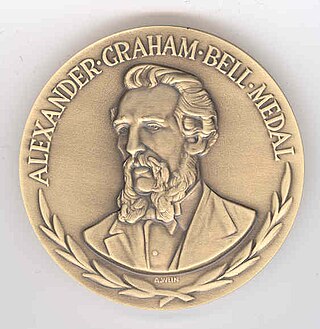
Robert Gray Gallager is an American electrical engineer known for his work on information theory and communications networks.

Gerard Joseph Foschini, was an American telecommunications engineer who worked for Bell Laboratories from 1961 until his retirement. He died in September 2023. His research has covered many kinds of data communications, particularly wireless communications and optical communications. Foschini has also worked on point-to-point systems and networks.
Arun N. Netravali is an Indian–American computer engineer credited with contributions in digital technology including HDTV. He conducted research in digital compression, signal processing and other fields. Netravali was the ninth President of Bell Laboratories and has served as Lucent's Chief Technology Officer and Chief Network Architect. He received his undergraduate degree from IIT Bombay, India, and an M.S. and a Ph.D. from Rice University in Houston, Texas, all in electrical engineering. Several global universities, including the Ecole Polytechnique Federale in Lausanne, Switzerland, have honored him with honorary doctorates.

Anurag Kumar was the Director of the Indian Institute of Science at Bangalore, India from 2014–2020. He is a professor at the Department of Electrical Communication Engineering, and has served as the Chairperson of the Electrical Sciences Division at the Indian Institute of Science, before being appointed as the Director in 2014.
Amos Edward Joel Jr. was an American electrical engineer, known for several contributions and over seventy patents related to telecommunications switching systems.
Stewart David Personick is an American researcher in telecommunications and computer networking. He worked at Bell Labs, TRW, and Bellcore, researching optical fiber receiver design, propagation in multi-mode optical fibers, time-domain reflectometry, and the end-to-end modeling of fiber-optic communication systems.

The IEEE Alexander Graham Bell Medal is an award honoring "exceptional contributions to communications and networking sciences and engineering" in the field of telecommunications. The medal is one of the highest honors awarded by the Institute of Electrical and Electronics Engineers (IEEE) for achievements in telecommunication sciences and engineering.

Arthur David Hall III was an American electrical engineer and a pioneer in the field of systems engineering. He was the author of a widely used engineering textbook A Methodology for Systems Engineering from 1962.
Krishan Sabnani is an Indian-American networking researcher. He has made many seminal contributions to the Internet infrastructure design, protocol design, and wireless networks. Krishan made a breakthrough in Internet re-design. The main idea behind this work was to separate control functions and complex software from the forwarding portions on Internet routers. This work made it possible for forwarding technologies to evolve and be deployed independently from control protocols. This contribution is a precursor to the current Software Defined Networking (SDN) revolution. A patent based on this work won the 2010 Edison Patent Award.
Ian Munro Ross FREng was an early pioneer in transistors, and for 12 years President of Bell Labs.
Debasis Mitra is an Indian-American mathematician, known for his numerous contributions to the theory of communication systems, control theory and queueing theory.

Asad Ali Abidi is a Pakistani-American electrical engineer. He serves as a tenured professor at University of California, Los Angeles, and is the inaugural holder of the Abdus Salam Chair at the Lahore University of Management Sciences (LUMS). He is best known for pioneering RF CMOS technology during the late 1980s to early 1990s. As of 2008, the radio transceivers in all wireless networking devices and modern mobile phones are mass-produced as RF CMOS devices.
John Sullivan Mayo is an American engineer, AT&T executive and seventh president of Bell Labs, known for contributions to the computer and telecommunications industry.
Joel Stanley Engel is an American electrical engineer who made fundamental contributions to the development of cellular networks.
John O. Limb is an Australian engineer, known for fundamental contributions to the development of digital video communications and holder of a series of patents related to computer communications.

Richard H. Frenkiel is an American engineer, known for his significant role in the early development of cellular telephone networks.

John Mathew Cioffi is an American electrical engineer, educator and inventor who has made contributions in telecommunication system theory, specifically in coding theory and information theory. Best known as "the father of DSL," Cioffi's pioneering research was instrumental in making digital subscriber line (DSL) technology practical and has led to over 400 publications and more than 100 pending or issued patents, many of which are licensed.

Bruce Edward Hajek is a Professor in the Coordinated Science Laboratory, the head of the Department of Electrical and Computer Engineering, and the Leonard C. and Mary Lou Hoeft Chair in Engineering at the University of Illinois Urbana–Champaign. He does research in communication networking, auction theory, stochastic analysis, combinatorial optimization, machine learning, information theory, and bioinformatics.
James F. Gibbons is an American electrical engineer and academic administrator. He is credited with starting the semiconductor device fabrication laboratory at Stanford University that enabled the semiconductor industry and created Silicon Valley.
Timothy M. Pinkston is an American computer engineer, researcher, educator and administrator whose work is focused in the area of computer architecture. He holds the George Pfleger Chair in Electrical and Computer Engineering and is a Professor of Electrical and Computer Engineering at University of Southern California (USC). He also serves in an administrative role as Vice Dean for Faculty Affairs at the USC Viterbi School of Engineering.








